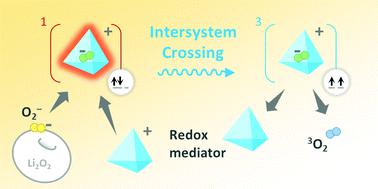当前位置:
X-MOL 学术
›
Energy Environ. Sci.
›
论文详情
Our official English website, www.x-mol.net, welcomes your feedback! (Note: you will need to create a separate account there.)
Suppressing singlet oxygen generation in lithium–oxygen batteries with redox mediators
Energy & Environmental Science ( IF 32.5 ) Pub Date : 2020-07-21 , DOI: 10.1039/d0ee01114b Zhuojian Liang 1, 2, 3, 4, 5 , Qingli Zou 1, 2, 3, 4, 5 , Jing Xie 1, 2, 3, 4, 5 , Yi-Chun Lu 1, 2, 3, 4, 5
Energy & Environmental Science ( IF 32.5 ) Pub Date : 2020-07-21 , DOI: 10.1039/d0ee01114b Zhuojian Liang 1, 2, 3, 4, 5 , Qingli Zou 1, 2, 3, 4, 5 , Jing Xie 1, 2, 3, 4, 5 , Yi-Chun Lu 1, 2, 3, 4, 5
Affiliation

|
Lithium–oxygen batteries promise high energy but suffer from poor cycle life owing to the generation of highly reactive singlet oxygen 1O2, which rapidly deactivates the electrode and the electrolyte. Here we demonstrate an effective strategy to suppress 1O2 using redox mediators. Using operando spectroscopy techniques, we show that 2,2,6,6-tetramethyl-1-piperidinyloxy (TEMPO), as a model redox mediator, drastically reduces 1O2 formation, increases the yield of ground state 3O2, and reduces the by-product generation. The 1O2 suppression effect is attributed to an increased intersystem crossing rate induced by redox mediators, with which the relaxation of a singlet-state intermediate to a triplet-state one is accelerated. We further show that this 1O2 suppression effect applies universally across six common redox mediators with up to three orders of magnitude higher 1O2 suppression efficiency compared to 1,4-diazabicyclo[2.2.2]octane (DABCO), the most efficient quencher used in Li–O2 batteries to date. From the comparison of the investigated mediators we discuss the plausible governing principle dictating redox mediators’ effectiveness in suppressing 1O2. Our study achieves effective 1O2 suppression and provides guidelines for designing redox mediators for efficient and reversible lithium–oxygen batteries.
中文翻译:

使用氧化还原介体抑制锂氧电池中的单线态氧生成
锂氧电池有望提供高能量,但由于会产生高反应性单线态氧1 O 2,因此循环寿命很短,单氧1 O 2会迅速使电极和电解质失活。在这里,我们演示了使用氧化还原介体抑制1 O 2的有效策略。使用操作光谱技术,我们显示2,2,6,6-四甲基-1-哌啶基氧基(TEMPO)作为模型氧化还原介体,可大幅减少1 O 2的形成,增加基态3 O 2的产率,并降低副产品的产生。的1 Ò 2抑制作用归因于由氧化还原介体引起的系统间交叉速率的增加,由此加速了单重态中间体向三重态中间体的松弛。我们进一步表明,这种1 O 2抑制作用普遍适用于六个常见的氧化还原介体,与最有效的1,4-二氮杂双环[2.2.2]辛烷(DABCO)相比,其1 O 2抑制效率高出三个数量级。迄今为止,Li–O 2电池中使用的淬火剂。通过对所研究的介体的比较,我们讨论了指导氧化还原介体抑制1 O 2有效性的合理控制原则。。我们的研究实现了有效的1 O 2抑制,并为设计用于高效可逆锂氧电池的氧化还原介体提供了指导。
更新日期:2020-09-16
中文翻译:

使用氧化还原介体抑制锂氧电池中的单线态氧生成
锂氧电池有望提供高能量,但由于会产生高反应性单线态氧1 O 2,因此循环寿命很短,单氧1 O 2会迅速使电极和电解质失活。在这里,我们演示了使用氧化还原介体抑制1 O 2的有效策略。使用操作光谱技术,我们显示2,2,6,6-四甲基-1-哌啶基氧基(TEMPO)作为模型氧化还原介体,可大幅减少1 O 2的形成,增加基态3 O 2的产率,并降低副产品的产生。的1 Ò 2抑制作用归因于由氧化还原介体引起的系统间交叉速率的增加,由此加速了单重态中间体向三重态中间体的松弛。我们进一步表明,这种1 O 2抑制作用普遍适用于六个常见的氧化还原介体,与最有效的1,4-二氮杂双环[2.2.2]辛烷(DABCO)相比,其1 O 2抑制效率高出三个数量级。迄今为止,Li–O 2电池中使用的淬火剂。通过对所研究的介体的比较,我们讨论了指导氧化还原介体抑制1 O 2有效性的合理控制原则。。我们的研究实现了有效的1 O 2抑制,并为设计用于高效可逆锂氧电池的氧化还原介体提供了指导。


























 京公网安备 11010802027423号
京公网安备 11010802027423号